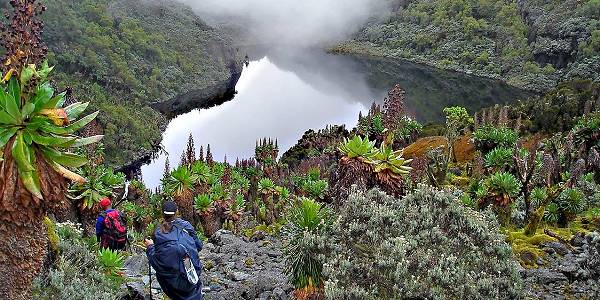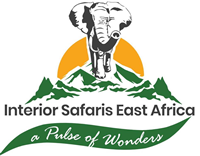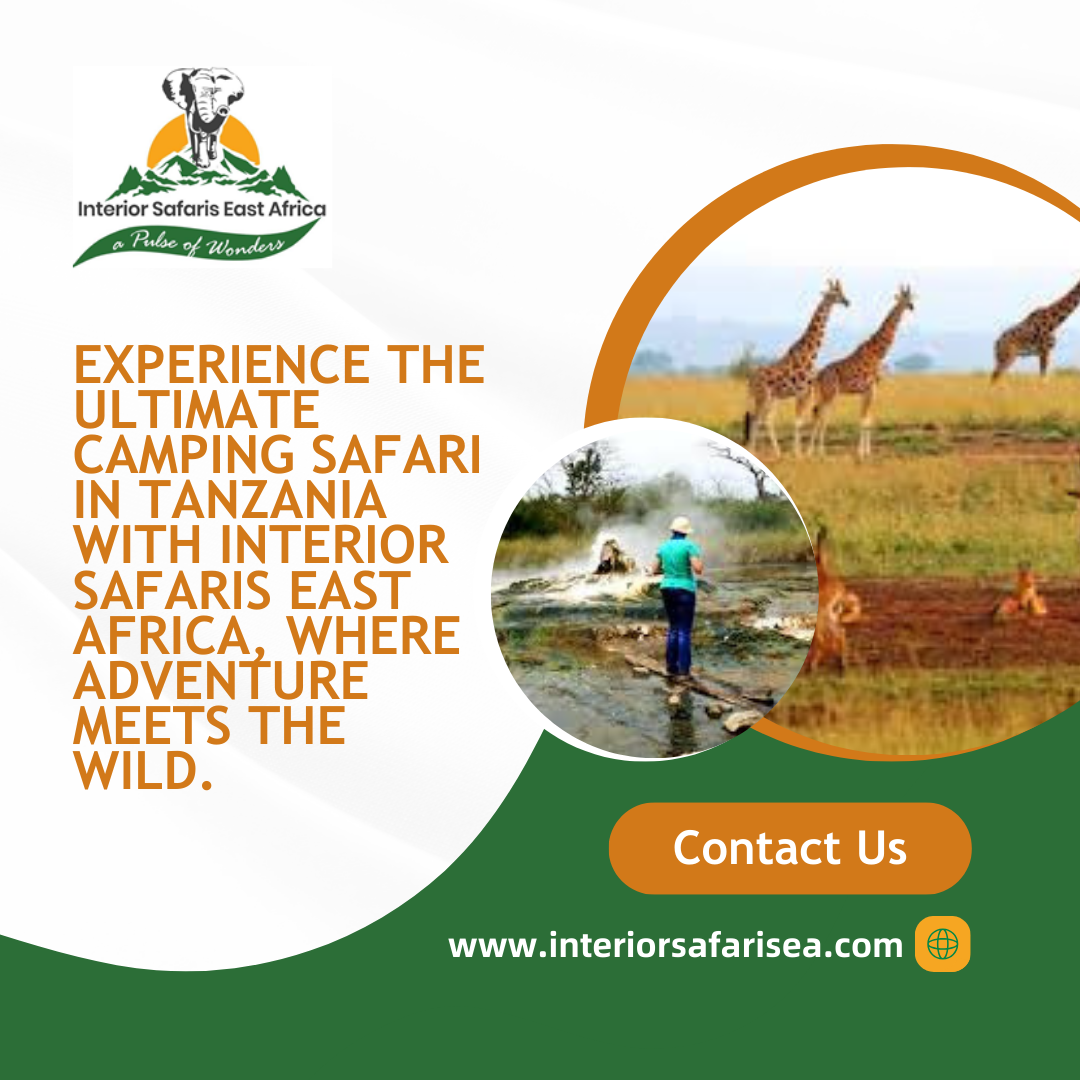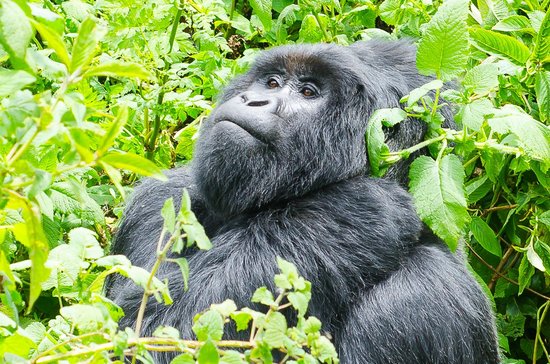 With a total area of 996 sq. kilometers protects the upper slopes of the Mountains of the Moon, which run for almost 120 kilometers along the Congolese border west of Kasese and Kabarole or Fort Portal. Thought to have been the source of the legend of the mountains of the moon, the snow-capped range is cited as the source of the Nile by the Roman geographer Ptolemy. The Rwenzori is the highest mountain range on the African continent with the highest peak being, Maragherita standing at 5,109 meters above sea level followed by Alexandra at 5,083 meters on mount Stanley are exceeded in altitude elsewhere in Africa only by Kilimanjaro and Mount Kenya, both of which are extinct volcanoes standing in isolation above the surrounding plains. The Rwenzori mountains are unique among the east Africa’s major peaks in that they are not volcanic in origin, but they do rise directly from the rift valley floor and their formation, like that of Kilimanjaro and Kenya, was linked to the geological upheaval that created the Great Rift Valley
With a total area of 996 sq. kilometers protects the upper slopes of the Mountains of the Moon, which run for almost 120 kilometers along the Congolese border west of Kasese and Kabarole or Fort Portal. Thought to have been the source of the legend of the mountains of the moon, the snow-capped range is cited as the source of the Nile by the Roman geographer Ptolemy. The Rwenzori is the highest mountain range on the African continent with the highest peak being, Maragherita standing at 5,109 meters above sea level followed by Alexandra at 5,083 meters on mount Stanley are exceeded in altitude elsewhere in Africa only by Kilimanjaro and Mount Kenya, both of which are extinct volcanoes standing in isolation above the surrounding plains. The Rwenzori mountains are unique among the east Africa’s major peaks in that they are not volcanic in origin, but they do rise directly from the rift valley floor and their formation, like that of Kilimanjaro and Kenya, was linked to the geological upheaval that created the Great Rift Valley
The Rwenzori is primarily known for its challenging hiking and climbing possibilities, but the range also supports a diversity of animals, including 70 mammal and 177 bird species, several of the latter being Albertine rift endemics. It’s the only national park in Uganda where the Angola colobus has been recorded, though identification of this localized monkey will require careful examination as the similar and wider spread black and white colobus also occur on the mountain ranges.
Like other large mountains in East Africa, the Rwenzori range can be divided into several altitude zones, each with its own distinct unique flora and fauna. The forest zone which starts at around 1,800m, has the most varied fauna. The only mammals you are likely to see in the forest are the aforementioned colobus and blue monkeys, though several other large mammals are present, including elephant, golden cat, several genet, chimps, yellow-backed duiker and giant forest hog. At night we always listen to the distinctive call of the southern tree hyrax.
The forest zone is home to a diversity and variety of birds, including Rwenzori Turaco which is now among the top 10 birds on the Uganda checklist, Long Eared Owl, Barred Long-Tailed cuckoo one of the shyest and high canopy spp, Handsome Francolin, Archer’s Ground Robin, Rwenzori Batis very endemic to the Albertine Rift Valley, Montane Sooty Boubou, Lagden’s Bush-Shrike, Golden-winged sunbird, strange weaver among those to look out for.
There is a good network of trails and huts on the mountains. The peaks are generally only tackled by experienced climbers. Most people stick to the loop trail which takes six to seven days and reaches an altitude of 4,372m. It is possible to do a shorter three day hike through the forested foothills into the moorland zone, or to spend longer on the mountain in order to divert from the main loop to some of the peaks. It should be stressed that hiking in the Rwenzori requires above average fitness and stamina, largely due to the muddy condition of the trails. Most people regard the Rwenzori loop trail to be a tougher hike than the ascent of either Mount Kilimanjaro or Mount Kenya, come try it out on one of our Uganda hiking safaris.
Mammals are scarce above the forest zone, but there are a few birds to look out for , the lamer geyer (bearded vulture) and black eagle are commonly seen soaring overhead while the alpine and the scarce swifts and scarlet-turfed malachite sunbird are practically restricted to the high altitude habitats in the east Africa.
Mountain climbing is the most attractive activity on the legendary mountains of the moon that lies between an altitude of between o degrees06’ south and 0degrees 46 north and longitude 29degrees47’ west and 30 degrees 11’ east. It is diverse heavily snowcapped peaks are one of the few pristine and spectacular landscape of the world. Trekking can be done along two routes a7 days trek of the central circuit, and a 5 days tour along the kilembe route to the southern part of the park. Shorter hikes for example for a day can also be arranged. The trees in the park allow visitors and up close with nature on a nature walk.
The six day loop trail is a tough but rewarding hike taking in all vegetation zones and the glacier peaks. There are ascents to major peaks within the Rwenzori ranges along both routes. These include ascents to magherita (5109m), on mount Stanley, vittorio Emmanuelle (4889m), on mount Speke and Edward (4842m) on Mount Baker. These hikes offer commanding and panoramic views of other peaks within the ranges. However high peaks should only be attempted by experienced hikers only.
The park is located near Kasese western Uganda on the boarder of Uganda and conjoins the west. The Nyakalengija trailhead which is 22km off the Kasese, fort portal road and 25km north of Kasese town can be reached from Kampala via fort portal road (375km) or via Mbarara and Queen Elizabeth national park (450kms, (www.interiorsafarisea.com )
9 Day Rwenzori Mountains Hike (Climbing) Safari In Uganda
Brought to you by Lifetime Experience Safaris, when it comes to safari Travel we know you have a lot of choices
 Day 1
Day 1
Drive from Kampala to Kasese Town. Shop all food needed up in the mountain. Register with RMS offices. Dinner and overnight at Hotel Magherita or Rwenzori Base Mountain Camp.
Day 2
After breakfast, drive to Ibanda, the park headquarters and the Rwenzori Mountaineering services (RMS) at Nyakalenjiga (5400ft/1646m) arrange payments, rent equipment and select guides and porters. Start hiking from this point up to Nyabitaba Hut (8700ft/2652m) and overnight. Hiking may take 5-7 hours.
Day 3
Follow the trail from Nyabitaba hut leading to Kurt Shaffer Bridge crossing Bujuku and Mubuku rivers. From this point it is steep and slippery. Continue the hike up to John Matte hut (11200ft/3415m) and overnight. Day’s hiking may take 7 hours. Slow hikers can consider going back from this point.
Day 4
From John Matte you will cross River Bujuku and enter the Bigo bog. cross the drier ground up to Lake Bujuku overlooking Mt. Baker and speke to the north. Follow the trail up to Bujuku Hut (13000 ft 3962m)the Hike may take 3-5 hours.
Day 5
From Bujuku Hut, hike to Scott Elliot leading to Elena Hut (14,700 ft / 44300m). This the end point for the central circuit. At the same time it is the starting point to climb Margherita peak (16763 ft /5109m) or Mt Stanley. (You will need 2 extra days to climb to the peaks) Follow the central circuit through the alpine zone of sparse low vegetation to crater lakes and drop to Lake Kitandara hut and overnight.
Day 6
Descend from Lake Kitandara hut leaving Megharita peak northwards and Democrat Republic of Congo westwards and on clear days you will see big area of Congo and the famous tropical forests of Congo. Descend up to Guy Yeoman Hut (10700ft/3261m).
Day 7
Descend to Nyabitaba Hut. The journey is long and may be difficult of deep mud and river crossing. This may take you 5 hours. Should you decide to descend up to Nyakalegila it may take you anther 2-p3 hours.
Day 8
From Nyabitaba Hut, descend to Nyakalengija the park headquarters. You will meet your driver to drive you back to Kasese town to your hotel for warm showers and relax. Dinner and overnight.
Day 9
After breakfast drive to Kampala or Entebbe in case your flight connections.
End of hiking
NOTE: Climbing to the peaks of Margarita/ Stanley/ Speke/ Alexandria.
One needs about 2 more days. That means the entire journey/trip will require a total of 11 to 12days. You could email us for more information regarding hiking.
Trekking Note:
Trekking takes place throughout the time and starts from Ibanda (starting point) at foot of Mountain Rwenzori. Our safari starts and ends in Kampala
Participants carry hiking shoes, sleeping bags and warm clothes
Climbing to the peaks will require ice axe, mountain boots, crampons, ropes and prior booking arrangements.
Mountain climbing/hiking takes place throughout the year, however, the months of April, May, October and November experience more rains but this does not stop hiking activities.
Accommodation in Kampala before and after the trek plus airports, transfers can be arranged on request.
The safari cost Includes:
8 nights’ accommodation and meals at full board
Park fees, hiking fees, food, porters, guides and cook.
4×4 WD vehicles with fuel and driver/guide
Rescue fees
Below are our Optional safari add on at an extra cost
3 Days gorilla tracking in Bwindi national park
1 Day white water rafting on River Nile
1 Day visit to orphanage chimps- Ngamba Island
Drinks, bar bills, phone calls, personal insurance, and expenses of personal nature like souvenirs, tips, laundry, etc.
Feel free to contact us any time and book this Safari tour. We are here to answer any questions you may have. Whether its safari itineraries, competitive pricing or general information on any of our services/tours, we are just a phone call or few clicks away, e-mail Us today, …we look forward to hearing from you.



